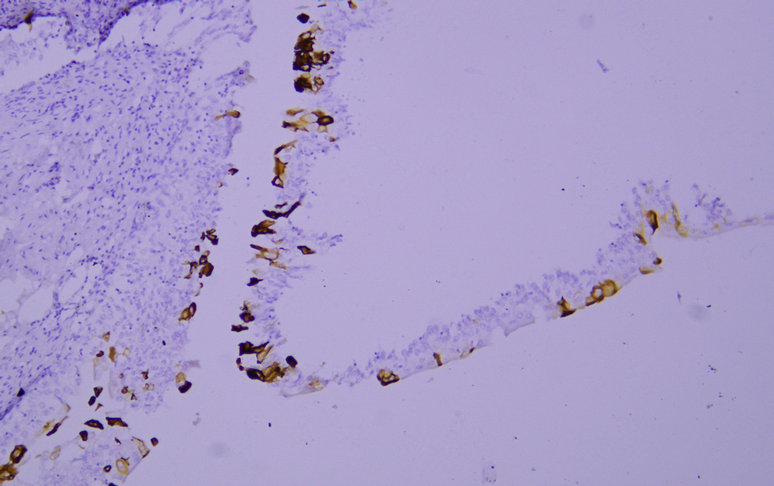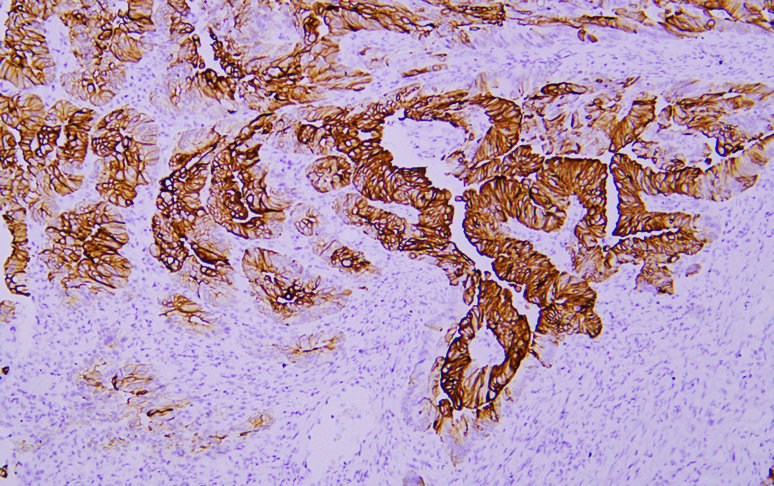Cytokeratin 20 (CK20) (ABT24R) rabbit mAb
- Catalog No.:YM7261
- Applications:IHC; ELISA
- Reactivity:Human;Mouse (predicted: Rat)
- Target:
- Cytokeratin 20
- Fields:
- >>Estrogen signaling pathway;>>Staphylococcus aureus infection
- Gene Name:
- KRT20
- Protein Name:
- Cytokeratin-20
- Human Gene Id:
- 54474
- Human Swiss Prot No:
- P35900
- Immunogen:
- Synthesized peptide derived from human CK20 AA range:300-424
- Specificity:
- This antibody detects endogenous levels of Cytokeratin 20
- Formulation:
- PBS, 50% glycerol, 0.05% Proclin 300, 0.05%BSA
- Source:
- Monoclonal, Rabbit IgG1, Kappa
- Dilution:
- IHC 1:100-500, ELISA 1:5000-20000
- Purification:
- Recombinant Expression and Affinity purified
- Storage Stability:
- -15°C to -25°C/1 year(Do not lower than -25°C)
- Other Name:
- CD20;CK 20;CK-20;CK20;CytokeRatin-20;CytokeRatin20;K1C20_HUMAN;K20;KA20;KeRatin 20;keRatin 20, type I;keRatin 21, Rat, homolog of;KeRatin;KeRatin type I cytoskeletal 20;KeRatin-20;KeRatin20;KRT 20;KRT 21;KRT20;KRT21;MGC35423;OTTHUMP00000164518;Protein IT;type I cytoskeletal 20
- Background:
- The protein encoded by this gene is a member of the keratin family. The keratins are intermediate filament proteins responsible for the structural integrity of epithelial cells and are subdivided into cytokeratins and hair keratins. The type I cytokeratins consist of acidic proteins which are arranged in pairs of heterotypic keratin chains. This cytokeratin is a major cellular protein of mature enterocytes and goblet cells and is specifically expressed in the gastric and intestinal mucosa. The type I cytokeratin genes are clustered in a region of chromosome 17q12-q21. [provided by RefSeq, Jul 2008],
- Function:
- developmental stage:First detected at embryonic week 8 in individual 'converted' simple epithelial cells of the developing intestinal mucosa. In later fetal stages, synthesis extends over most goblet cells and a variable number of villus enterocytes. In the developing gastric and intestinal mucosa, expressed in all enterocytes and goblet cells as well as certain 'low-differentiated' columnar cells, whereas the neuroendocrine and Paneth cells are negative.,function:Plays a significant role in maintaining keratin filament organization in intestinal epithelia. When phosphorylated, plays a role in the secretion of mucin in the small intestine.,miscellaneous:There are two types of cytoskeletal and microfibrillar keratin: I (acidic; 40-55 kDa) and II (neutral to basic; 56-70 kDa).,PTM:Hyperphosphorylation at Ser-13 occurs during the early stages of apoptosis but becomes less prominent during t
- Subcellular Location:
- Cytoplasmic, Membranous
- Expression:
- Expressed predominantly in the intestinal epithelium. Expressed in luminal cells of colonic mucosa. Also expressed in the Merkel cells of keratinized oral mucosa; specifically at the tips of some rete ridges of the gingival mucosa, in the basal layer of the palatal mucosa and in the taste buds of lingual mucosa.
- June 19-2018
- WESTERN IMMUNOBLOTTING PROTOCOL
- June 19-2018
- IMMUNOHISTOCHEMISTRY-PARAFFIN PROTOCOL
- June 19-2018
- IMMUNOFLUORESCENCE PROTOCOL
- September 08-2020
- FLOW-CYTOMEYRT-PROTOCOL
- May 20-2022
- Cell-Based ELISA│解您多样本WB检测之困扰
- July 13-2018
- CELL-BASED-ELISA-PROTOCOL-FOR-ACETYL-PROTEIN
- July 13-2018
- CELL-BASED-ELISA-PROTOCOL-FOR-PHOSPHO-PROTEIN
- July 13-2018
- Antibody-FAQs
- Products Images

- Immunohistochemical analysis of paraffin-embedded human Bladder. 1, Antibody was incubated at 4° overnight. 2, TRIS-EDTA of pH8.0 was used for antigen retrieval. 3,Secondary antibody was diluted at 1:200(room temperature, 30min).

- Immunohistochemical analysis of paraffin-embedded human Colon carcinoma. 1, Antibody was incubated at 4° overnight. 2, TRIS-EDTA of pH8.0 was used for antigen retrieval. 3,Secondary antibody was diluted at 1:200(room temperature, 30min).



